 W
WThe McDonnell Douglas A-4G Skyhawk is a variant of the Douglas A-4 Skyhawk attack aircraft developed for the Royal Australian Navy (RAN). The model was based on the A-4F variant of the Skyhawk, and was fitted with slightly different avionics as well as the capacity to operate AIM-9 Sidewinder air-to-air missiles. The RAN received ten A-4Gs in 1967 and another ten in 1971, and operated the type from 1967 to 1984.
 W
WThe McDonnell Douglas/General Dynamics A-12 Avenger II was a proposed American attack aircraft from McDonnell Douglas and General Dynamics. It was to be an all-weather, carrier-based stealth bomber replacement for the Grumman A-6 Intruder in the United States Navy and Marine Corps. Its Avenger II name was taken from the Grumman TBF Avenger of World War II.
 W
WThe McDonnell Douglas AV-8B Harrier II is a single-engine ground-attack aircraft that constitutes the second generation of the Harrier Jump Jet family. Capable of vertical or short takeoff and landing (V/STOL), the aircraft was designed in the late 1970s as an Anglo-American development of the British Hawker Siddeley Harrier, the first operational V/STOL aircraft. The aircraft is primarily employed on light attack or multi-role missions, ranging from close air support of ground troops to armed reconnaissance. The AV-8B is used by the United States Marine Corps (USMC), the Spanish Navy, and the Italian Navy. A variant of the AV-8B, the British Aerospace Harrier II, was developed for the British military, while another, the TAV-8B, is a dedicated two-seat trainer.
 W
WThe Boeing 717 is a twin-engine, single-aisle jet airliner, developed for the 100-seat market. The airliner was designed and originally marketed by McDonnell Douglas as the MD-95, a derivative of the DC-9 family. Capable of seating up to 134 passengers, the 717 has a design range of 2,060 nautical miles (3,820 km). It is powered by two Rolls-Royce BR715 turbofan engines mounted at the rear of the fuselage.
 W
WThe McDonnell Douglas C-9 was a military version of the McDonnell Douglas DC-9 airliner. It was produced as the C-9A Nightingale for the United States Air Force, and the C-9B Skytrain II for the U.S. Navy and Marine Corps. The final flight of the C-9A Nightingale was in September 2005, and the C-9C was retired in September 2011. The U.S. Navy retired its last C-9B in July 2014. The two remaining C-9s in Marine service were retired in April 2017.
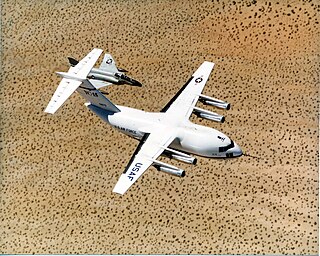 W
WThe McDonnell Douglas YC-15 is a prototype four-engine short take-off and landing (STOL) tactical transport. It was McDonnell Douglas' entrant into the United States Air Force's Advanced Medium STOL Transport (AMST) competition to replace the Lockheed C-130 Hercules as the USAF's standard STOL tactical transport. In the end, neither the YC-15 nor the Boeing YC-14 was ordered into production, although the YC-15's basic design would be used to form the successful McDonnell Douglas C-17 Globemaster III.
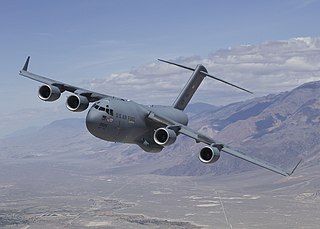 W
WThe McDonnell Douglas/Boeing C-17 Globemaster III is a large military transport aircraft that was developed for the United States Air Force (USAF) from the 1980s to the early 1990s by McDonnell Douglas. The C-17 carries forward the name of two previous piston-engined military cargo aircraft, the Douglas C-74 Globemaster and the Douglas C-124 Globemaster II. The C-17 commonly performs tactical and strategic airlift missions, transporting troops and cargo throughout the world; additional roles include medical evacuation and airdrop duties. It was designed to replace the Lockheed C-141 Starlifter, and also fulfill some of the duties of the Lockheed C-5 Galaxy, freeing the C-5 fleet for outsize cargo.
 W
WThe McDonnell Douglas CF-18 Hornet is a Royal Canadian Air Force (RCAF) variant of the American McDonnell Douglas F/A-18 Hornet fighter aircraft. In 1980, the F/A-18 was selected as the winner of the New Fighter Aircraft Project competition and awarded a production order; deliveries of the CF-18 to the Canadian Forces began in 1982. CF-18s have supported North American Aerospace Defense Command (NORAD) air sovereignty patrols and participated in combat during the Gulf War in 1991, the Kosovo War in the late 1990s, and as part of the Canadian contribution to the international Libyan no-fly zone in 2011. CF-18s were also part of the Canadian contribution to the military intervention against ISIL, Operation Impact.
 W
WThe Douglas DC-8 is a narrow-body airliner built by the American Douglas Aircraft Company. After losing the May 1954 USAF tanker requirement to the Boeing KC-135, Douglas announced in July 1955 its derived jetliner project. In October 1955, Pan Am made the first order along with the competing Boeing 707, and many other airlines followed. The first DC-8 was rolled out in Long Beach Airport on 9 April 1958 and flew for the first time on 30 May. FAA certification was achieved in August 1959 and the DC-8 entered service with Delta Air Lines on September 18.
 W
WThe McDonnell Douglas DC-9 is a single-aisle airliner designed by the Douglas Aircraft Company. After introducing its heavy DC-8 in 1959, Douglas approved the smaller, all-new DC-9 for shorter flights on April 8, 1963. The DC-9-10 first flew on February 25, 1965 and gained its type certificate on November 23, to enter service with Delta Air Lines on December 8. With five seats across in economy, it had two rear-mounted Pratt & Whitney JT8D turbofans under a T-tail for a cleaner wing, a two-person flight deck and built-in airstairs.
 W
WThe DC-10 Air Tanker is a series of American wide-body jet air tankers, which have been in service as an aerial firefighting unit since 2006. The aircraft, operated by the joint technical venture 10 Tanker Air Carrier, are converted wide body McDonnell Douglas DC-10 passenger jetliners, and are primarily used to fight wildfires, typically in rural areas. The turbofan-powered aircraft carry up to 45,000 Liters of water or fire retardant in an exterior belly-mounted tank, the contents of which can be released in eight seconds. Four air tankers are currently in operation, all DC-10-30 aircraft, with the call-signs Tanker 910, 911, 912 and 914. The original Tanker 910, a DC-10-10, was retired in 2014.
 W
WThe McDonnell Douglas DC-10 is an American wide-body airliner manufactured by McDonnell Douglas. The DC-10 was intended to succeed the DC-8 for long range flights. It first flew on August 29, 1970; and was introduced on August 5, 1971 by American Airlines.
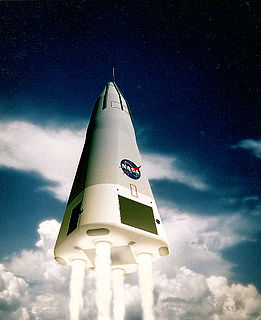 W
WThe DC-X, short for Delta Clipper or Delta Clipper Experimental, was an uncrewed prototype of a reusable single-stage-to-orbit launch vehicle built by McDonnell Douglas in conjunction with the United States Department of Defense's Strategic Defense Initiative Organization (SDIO) from 1991 to 1993. Starting 1994 until 1995, testing continued through funding of the US civil space agency NASA. In 1996, the DC-X technology was completely transferred to NASA, which upgraded the design for improved performance to create the DC-XA.
 W
WThe McDonnell Douglas F-15 Eagle has been in service with the United States Air Force since 1976. Israel, Japan, Saudi Arabia and other nations also operate the aircraft. The units it has been assigned to, and the bases it has been stationed are listed below.
 W
WThe McDonnell Douglas F-15 Eagle is an American twin-engine, all-weather tactical fighter aircraft designed by McDonnell Douglas. Following reviews of proposals, the United States Air Force selected McDonnell Douglas's design in 1967 to meet the service's need for a dedicated air superiority fighter. The Eagle first flew in July 1972, and entered service in 1976. It is among the most successful modern fighters, with over 100 victories and no losses in aerial combat, with the majority of the kills by the Israeli Air Force.
 W
WThe McDonnell Douglas F-15E Strike Eagle is an American all-weather multirole strike fighter derived from the McDonnell Douglas F-15 Eagle. The F-15E was designed in the 1980s for long-range, high-speed interdiction without relying on escort or electronic-warfare aircraft. United States Air Force (USAF) F-15E Strike Eagles can be generally distinguished from other US Eagle variants by darker aircraft camouflage, conformal fuel tanks (CFTs) mounted along the engine intake ramps and a tandem-seat cockpit.
 W
WThe Northrop/McDonnell Douglas YF-23 is an American single-seat, twin-engine stealth fighter aircraft technology demonstrator designed for the United States Air Force (USAF). The design was a finalist in the USAF's Advanced Tactical Fighter (ATF) competition, battling the Lockheed YF-22 for a production contract. Two YF-23 prototypes were built, nicknamed "Black Widow II" and "Gray Ghost".
 W
WThe Harrier, informally referred to as the Harrier Jump Jet, is a family of jet-powered attack aircraft capable of vertical/short takeoff and landing operations (V/STOL). Named after a bird of prey, it was originally developed by British manufacturer Hawker Siddeley in the 1960s. The Harrier emerged as the only truly successful V/STOL design of the many attempted during that era. It was a subsonic aircraft, unlike most of its competitors. It was conceived to operate from improvised bases, such as car parks or forest clearings, without requiring large and vulnerable air bases. Later, the design was adapted for use from aircraft carriers.
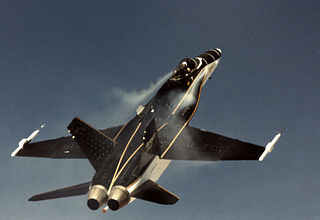 W
WThe High Alpha Research Vehicle was an American modified McDonnell Douglas F/A-18 Hornet used by NASA in a three-phase program investigating controlled flight at high alpha using thrust vectoring, modifications to the flight controls, and with actuated forebody strakes. The program lasted from April 1987 to September 1996.
 W
WThe McDonnell Douglas MD-11 is a wide-body airliner manufactured by American McDonnell Douglas (MDD) and later by Boeing. Following DC-10 development studies, the program was launched on December 30, 1986. Assembly of the first prototype began on March 9, 1988, it rolled out in September 1989 and made its maiden flight on January 10, 1990. FAA certification was achieved on November 8, the first delivery was to Finnair on December 7, and it entered service on the 20th.
 W
WThe McDonnell Douglas MD-12 was a "superjumbo" airliner planned by the McDonnell Douglas company in the 1990s. It was first conceived as a trijet larger than the MD-11, then stretched to a quadjet airliner. It was to be similar in size to the Boeing 747, but with greater passenger capacity. However, the MD-12 received no orders and was canceled. McDonnell Douglas then studied larger MD-11 derivatives named MD-XX without proceeding.
 W
WThe McDonnell Douglas MD-80 is a series of single-aisle airliners developed by McDonnell Douglas from the earlier DC-9. Stretched, heavier, and with higher bypass Pratt & Whitney JT8D-200 engines, the DC-9 Series 80 was launched in October 1977. It made its first flight on October 18, 1979 and was certified on August 25, 1980. It was first delivered to launch customer Swissair on September 13, 1980, which introduced it into commercial service on October 10, 1980.
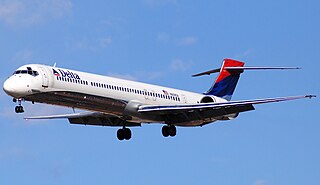 W
WThe McDonnell Douglas MD-90 is a single-aisle airliner developed by McDonnell Douglas from the MD-80, itself derived from the DC-9. After the more fuel-efficient IAE V2500 high-bypass turbofan was selected, Delta Air Lines became the launch customer on November 14, 1989. It first flew on February 22, 1993 and the first MD-90 was delivered to Delta in February 1995.
 W
WThe McDonnell Douglas MD-94X was a planned propfan-powered airliner, intended to begin production in 1994. Announced in January 1986, the aircraft was to seat between 160 and 180 passengers, possibly using a twin-aisle configuration. An all-new design that was investigated internally since at least 1984, the MD-94X was developed in the mid-1980s to compete with the similar Boeing 7J7. The price of oil would have to be at least US$1.40 per gallon for McDonnell Douglas to build the plane, though. Configuration was similar to the MD-80, but advanced technologies such as canard noseplanes, laminar and turbulent boundary layer control, side-stick flight control, and aluminum-lithium alloy construction were under consideration. Airline interest in the brand-new propfan technology was weak despite claims of up to a 60% reduction in fuel use, and both aircraft were canceled.
 W
WThe Boeing 717 is a twin-engine, single-aisle jet airliner, developed for the 100-seat market. The airliner was designed and originally marketed by McDonnell Douglas as the MD-95, a derivative of the DC-9 family. Capable of seating up to 134 passengers, the 717 has a design range of 2,060 nautical miles (3,820 km). It is powered by two Rolls-Royce BR715 turbofan engines mounted at the rear of the fuselage.
 W
WThe BAE Systems SkyEye is a reconnaissance UAV developed in the United States in the early 1970s by Developmental Sciences Inc, later called Developmental Sciences Corporation, a division of Lear Astronics Corporation and ultimately part of BAE Systems. Developmental Sciences Inc was one of the first US companies to investigate battlefield UAVs, flying the first prototype of the SkyEye series in 1973, leading to the first flight of the improved R4E variant in 1981. The R4E has been continuously refined since then in a sequence of subvariants.
 W
WThe McDonnell Douglas T-45 Goshawk is a highly modified version of the British BAE Systems Hawk land-based training jet aircraft. Manufactured by McDonnell Douglas and British Aerospace, the T-45 is used by the United States Navy as an aircraft carrier-capable trainer.
 W
WThe McDonnell Douglas X-36 Tailless Fighter Agility Research Aircraft was an American stealthy subscale prototype jet designed to fly without the traditional tail assembly found on most aircraft. This configuration was designed to reduce weight, drag and radar cross section, and increase range, maneuverability and survivability.